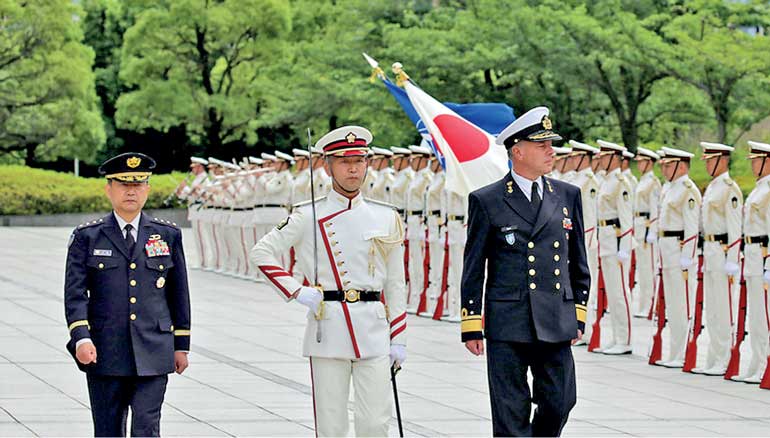Thursday Jan 01, 2026
Thursday Jan 01, 2026
Wednesday, 28 December 2022 00:00 - - {{hitsCtrl.values.hits}}

By Dammika Adhikari
Japan reached a critical milestone in efforts to reshape its defence strategy, increase national defence allocations, and allow Tokyo to acquire an offensive counter strike missile capability. On 16 December, Japanese Prime Minister Kishida Fumio’s cabinet approved the nation’s three key security documents, which will mark a major turning point in Japan’s post-war policy of maintaining an exclusively defence-oriented policy to counter any aggression emerging for his potential adversaries.
Japan is in the process of returning to “a normal nation” after curtailing its military buildup after World War II which is gradually exploiting its offensive capabilities to strike against enemy missile bases in the offensive against their country.
Japan’s National Security Strategy is based on three major concepts such as “under the vision of a Free and Open Indo-Pacific (FOIP), it is vitally important for Japan’s security to cooperate with allies and likeminded countries to ensure peace and stability in the region.” Those countries mentioned in the National Security Strategy are the United States, Australia, India, the United Kingdom, France, Germany, Italy, Canada, New Zealand, South Korea, and Southeast Asian nations, among others. The other two strategies included the Defence Buildup Program (DBP), which was approved along with the national security strategy for the first time with all these policy documents. Japan will shape the overall strategy of the defence budget, defence policy, and defence acquisition goals.
The defence program lays out total defence expenditure and procurement volumes for major equipment for the next five to ten years. Japan increased defence spending to 43 trillion yen ($ 314 billion) from the fiscal year 2023 to 2027. This is a 56.5% increase from the 27.47 trillion yen in the current five-year plan, which covers the fiscal year 2019 to 2023. This will increase Japan’s defence spending to the NATO standard of 2% of the national GDP in 2027 − following Kishida’s instructions to his defence and finance ministers to do so in late November. The recent allocation of more money to defence spending will allow Japan to acquire counterforce strike missiles such as Tomahawk cruise missiles.
Is this an exit from Japan’s exclusively defence-oriented policy?
Acquiring such a missile counter strike capability, defence authorities believe that missile strike capabilities in the region have significantly improved in both qualitative and quantitative terms. If Japan continues to rely only upon ballistic missile defences (BMD), it will become increasingly difficult for Japan to fully address missile threats with its existing missile defence network alone. Japan believes this counter strike capability is within the scope of the pacifist Japanese Constitution and international law, and will not change the concept of exclusively defence-oriented policy, called Senshi boei in Japanese. There will be no change in Japan’s prohibition of preemptive strikes.
Is China a threat?
Japan’s defence white paper was published in June 2022 identifying key threats in the contemporary environment such as China’s civil-military fusion and military intelligentisation and unilateral Russian aggression against Ukraine. However, notably, Japan avoided specifying China as a “threat” even in the updated documents. A major reason for that is the ruling Liberal Democratic Party’s political consideration for its junior coalition partner, Komeito, which is backed by Soka Gakkai, Japan’s largest lay Buddhist group. Historically, this religious organisation has strong ties with Beijing as it helped lay the groundwork for then-Prime Minister Tanaka Kakuei and his foreign minister, Ohira Masayoshi, to normalise diplomatic relations with China in 1972.
However, Japan has identified North Korea as “an even more grave and imminent threat to Japan’s national security than ever before.” Japan’s government keeps a critical eye on China’s national goals, military trends, and military capabilities. “China is the second largest economy in the world, so we need to encourage them to be firmly engaged in the international framework. With some aspects such as military, economic, and diplomatic aspects, it is not a good idea to simply use the word ‘threat’ toward China,” the official said.
The Chinese activities in south China and the sea, disputes over maritime boundaries, and expansion of Chinese exclusive air defence zones are key issues that critically affected Japan›s capabilities. Japan has been augmenting the capabilities of its military forces from self-defence forces to potential capabilities with hybrid military forces.
(The writer has a Bachelor’s and Master’s in Security and Strategic Studies from the General Sir John Kotelawala Defence University and experience in discussing and disseminating knowledge in various levels of fora over 10 years.)